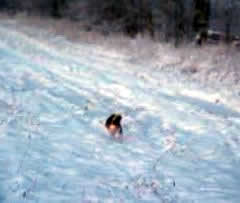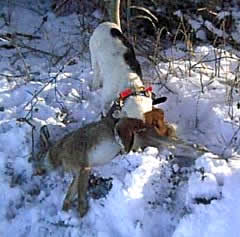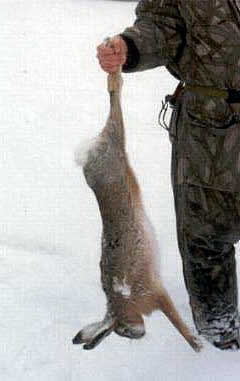 |
|
|
Hunting the European Hareby Jeff Caldwell :: Featured: December, 2002 With a fresh layer of snow the rabbit tracks running down the overgrown fence line stood out from the otherwise white landscape. The young beagles where working about 100 yards ahead and by the way they where acting I could tell that there would soon be a jump. Sure enough 6 feet off the fence line the snow exploded in all directions as a jackrabbit (European hare) left his hiding spot in the snow bank.
Not everyone has the opportunity to hunt the challenging European hare, as their distribution is limited to most areas of Southern Ontario, and into some neighboring states. But if the opportunity presents itself then I encourage you give it a try!
Jackrabbits are a large hare and weigh between 7-12 pounds. I have personally seen them go 15-17 pounds but this is above average. They can reach speeds nearing 50 km per hour, but cannot sustain such speeds for long periods of time. European hare feed on field crops during the spring and summer months, and will forage in such fields until the snow becomes too deep. The jackrabbits spend the winter months browsing on saplings and buds that grow in and around fence lines, red willow swamps, and new growth hardwoods.
Favorite areas for jackrabbit hunters to look for their game are farmland with fencerows, red willow swamps, and hardwoods with young growth. Basically anywhere there is young sapling growth within reach of your quarry. Almost all jackrabbit hunting is done during the winter when snow is on the ground, as they tend not to live in close proximity to each other as do other hare which makes locating them very difficult. When hunting these areas, a favorite trick in my area is to drive the less traveled back roads and look for fresh tracks going up and down the fence lines. More often than not you can spot a set of large ears or a tuft of brown fur tucked in amongst a thicket. During heavy snowfall hunters also look for spots where jacks have burrowed into a snow bank, letting the snow cover them completely over. This provides excellent warmth and shelter for the hare and makes for some startled hunters as well! The hunters unload the hounds and walk up the fence lines letting the dogs range out ahead, it is not uncommon to get a shot on the jump as it usually occurs in fairly open country. As with any game avoiding long shots is a good idea, and experience has taught me to hold off as a better opportunity will usually present itself. My biggest reason for letting the jack have a circle is for the pure enjoyment of seeing a beagle or two in hot pursuit! The speed of beagles for hunting this hare is as widely discussed as in other types of rabbit hunting, and comes down to personal preference. I prefer a faster beagle to keep the momentum of the chase going, but others enjoy a medium speed dog as the jack will then usually keep a tighter circle. Firearms of choice for jackrabbit hunters varies widely, perhaps more than any other type of rabbit hunting. Shotgun ranges are not uncommon but a 20 or 12 ga., with a heavy load of #4, 2 or BB, is needed to put down this hefty hare. The .22 caliber rim fire is my personal choice, but I have also used the lighter .22 caliber center fires such as .222, .223, and 22-250 for hunting very open country. If you ever get the opportunity to run European hare I strongly suggest you give it a try. It is truly a unique experience. I have also found that beagles adapt quite quickly to the running style and scent of a European hare, so don't be afraid to turn your pack loose! Happy hunting, and remember it's friends and family that make your hunting experiences more memorable. |
As an Amazon Associate we earn from qualifying purchases.
An absolute must have for any sporting dog owner. Save money on vet bills!
|
|||
Beagles & Rabbit Hunting Videos - DVD - FREE shipping!
Rabbit Hunting Online is a participant in the Amazon Services LLC Associates Program, an affiliate advertising program designed to provide a means for sites to earn advertising fees by advertising and linking to Amazon.com |

 The
European Hare, more commonly called a jackrabbit, was introduced to
southern Ontario in the early 1900's, not on purpose but accidentally
by the escape of some stock brought overseas from Europe. The jackrabbits
quickly spread out over the southern part of the province where they
still exist today.
The
European Hare, more commonly called a jackrabbit, was introduced to
southern Ontario in the early 1900's, not on purpose but accidentally
by the escape of some stock brought overseas from Europe. The jackrabbits
quickly spread out over the southern part of the province where they
still exist today.  When
hunting the European hare, the same basic concepts of rabbit hunting
apply. The "jacks" tend to make a full circle back to the
general area where they where jumped. Depending on the speed of the
hounds, snow conditions etc... they can stay ½ a mile or more
ahead of the pack, or as more often is the case 100-150 yards. The
biggest difference when hunting these hare is that everything is on
a larger scale; the circle they take can be upwards to a mile around.
When the snow gets too deep they have no problems with crossing or
running the roads, which makes it hazardous to the dogs. Tracking equipment
becomes a more necessary item, as the area the beagles are covering
is greatly increased. As well, it pays to have more hunters in the
area -- it can be quite difficult patterning a jackrabbit on your own!
When
hunting the European hare, the same basic concepts of rabbit hunting
apply. The "jacks" tend to make a full circle back to the
general area where they where jumped. Depending on the speed of the
hounds, snow conditions etc... they can stay ½ a mile or more
ahead of the pack, or as more often is the case 100-150 yards. The
biggest difference when hunting these hare is that everything is on
a larger scale; the circle they take can be upwards to a mile around.
When the snow gets too deep they have no problems with crossing or
running the roads, which makes it hazardous to the dogs. Tracking equipment
becomes a more necessary item, as the area the beagles are covering
is greatly increased. As well, it pays to have more hunters in the
area -- it can be quite difficult patterning a jackrabbit on your own! 
